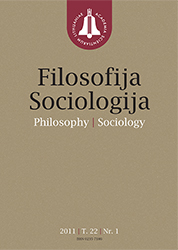 ISSN 0235-7186 ISSN 2424-4546 (online) |
2007 m. Nr. 3 The language of speaking about and reflecting on death: an analysis of L. Tolstoy’s story “The death of Ivan Ilyich”
This paper is an attempt to interpret the phenomenon of death, at least in terms of its relevance to our understanding of life, using L. Tolstoy’s story “The Death of Ivan Ilyich” as a congenial starting point. It is an important attribute of death that it fundamentally defies analysis, and, with human consciousness blocking our access to anything that does so, we find ourselves unable to “admit” death into ourselves or identify ourselves with it. Hence our efforts to come to terms with the phenomenon of death by reducing it to a kind of semiotic form expressed in the accepted practices of mourning and burial. The inevitable clash between the phenomenon of death and that of Dasein, whose topos of opposition is being itself, results in an antinomy which can only be resolved by addressing the phenomenal essence of both as a means of looking beyond their mere contents, clearing thereby a space for thought that is normally occupied by consciousness. L. Tolstoy’s treatment of his character’s dying reveals the fundamental solitude of a human being in the face of the most crucial experiences of human existence, such as pain and death. The indefinite nature of such phenomena reveals the power of the impersonal, making one turn to oneself, to one’s very presence in the world (cf. the notion of Dasein), the most authentic way of doing which is turning to one’s childhood. Keywords: phenomenology, phenomenon, life, death, time, Dasein, language, consciousness, thinking, reflection |
Numeriai:
2017 - T.28 Nr.1, Nr.2, Nr.3, Nr.4 2016 - T.27 Nr.1, Nr.2, Nr.3, Nr.4 2015 - T.26 Nr.1, Nr.2, Nr.3, Nr.4 2014 - T.25 Nr.1, Nr.2, Nr.3, Nr.4 2013 - T.24 Nr.1, Nr.2, Nr.3, Nr.4 2012 - T.23 Nr.1, Nr.2, Nr.3, Nr.4 2011 - T.22 Nr.1, Nr.2, Nr.3, Nr.4 2010 - T.21 Nr.1, Nr.2, Nr.3, Nr.4 2009 - T.20 Nr.1, Nr.2, Nr.3, Nr.4 2008 - T.19 Nr.1, Nr.2, Nr.3, Nr.4 2007 - T.18 Nr.1, Nr.2, Nr.3, Nr.4 2006 Nr.1, Nr.2, Nr.3, Nr.4 2005 Nr.1, Nr.2, Nr.3, Nr.4 2004 Nr.1, Nr.2, Nr.3, Nr.4 2003 Nr.1, Nr.2, Nr.3, Nr.4 2002 Nr.1, Nr.2, Nr.3, Nr.4 2001 Nr.1, Nr.2, Nr.3, Nr.4 |